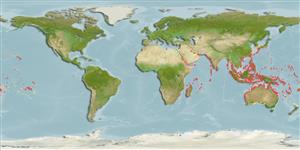>
Ovalentaria/misc (Various families in series Ovalentaria) >
Pomacentridae (Damselfishes) > Glyphisodontinae
Etymology: Abudefduf: Arabic, abu = father; this fish is the leader of the reef against other species (Ref. 45335).
More on authors: Quoy & Gaimard.
Environment: milieu / climate zone / depth range / distribution range
Sinh thái học
Biển Cùng sống ở rạn san hô; Ở đại duơng, biển (Ref. 51243); Mức độ sâu 0 - 15 m (Ref. 30874). Tropical; 36°N - 39°S, 26°E - 143°W
Indo-Pacific: Red Sea and eastern Africa to the Line and Tuamoto islands, north to southern Japan, south to Australia. Recorded in Bay of Islands, New Zealand (Ref. 35942). Often confused with the closely related Atlantic species Abudefduf saxatilis (Ref. 7247).
Length at first maturity / Bộ gần gũi / Khối lượng (Trọng lượng) / Age
Maturity: Lm 12.0 range ? - ? cm
Max length : 20.0 cm TL con đực/không giới tính; (Ref. 4391)
Các tia vây lưng cứng (tổng cộng) : 13; Các vây lưng mềm (tổng cộng) : 12 - 14; Tia cứng vây hậu môn: 2; Tia mềm vây hậu môn: 11 - 13. This species is characterized by having the following features: body depth 1.5-1.8 in SL; forked caudal fin; colour of body blue-green dorsally, shading to silvery white ventrally; five broad bluish black bars the first just behind the head, the narrow fifth on caudal peduncle, the third to fifth extending into the dorsal fin; dorsal part of body between the first and third dark bars often yellow (yellowish hue on anterodorsal part of the body apparent especially during courtship and nesting); caudal fin without dark bands (Ref. 11441, 90102).
Adults inhabit upper edge of outer reef slopes and inshore rocky reefs. Juveniles associated with drifting seaweed (Ref. 12114, 12115). Benthopelagic (Ref. 58302). Feed on zooplankton, benthic algae, and small invertebrates (Ref. 1602). Often in aggregations (Ref. 9710) feeding at midwater or tending nests among rocks and coral ledges (Ref. 90102). In large numbers at spawning sites that are timed with large tides that carry their pelagic offspring far offshore (Ref. 48636). Oviparous, distinct pairing during breeding (Ref. 205). Eggs are demersal and adhere to the substrate (Ref. 205). Males guard and aerate the eggs (Ref. 205). Minimum depth reported taken from Ref. 128797.
Oviparous, distinct pairing during breeding (Ref. 205). Eggs are demersal and adhere to the substrate (Ref. 205). Males guard and aerate the eggs (Ref. 205).
Allen, G.R., 1991. Damselfishes of the world. Mergus Publishers, Melle, Germany. 271 p. (Ref. 7247)
IUCN Red List Status (Ref. 130435: Version 2024-2)
Threat to humans
Reports of ciguatera poisoning (Ref. 30303)
Human uses
Các nghề cá: Các nghề cá là sinh kế; Bể nuôi cá: Tính thương mại
Các công cụ
Special reports
Download XML
Các nguồn internet
Estimates based on models
Preferred temperature (Ref.
123201): 21.9 - 29.3, mean 28.2 °C (based on 3494 cells).
Phylogenetic diversity index (Ref.
82804): PD
50 = 0.5000 [Uniqueness, from 0.5 = low to 2.0 = high].
Bayesian length-weight: a=0.02455 (0.01409 - 0.04276), b=3.07 (2.92 - 3.22), in cm total length, based on LWR estimates for this species & Genus-body shape (Ref.
93245).
Mức dinh dưỡng (Ref.
69278): 2.6 ±0.4 se; based on diet studies.
Generation time: 1.3 ( na - na) years. Estimated as median ln(3)/K based on 1
growth studies.
Thích nghi nhanh (Ref.
120179): Chiêù cao, thời gian nhân đôi của chủng quần tối thiểu là dưới 15 tháng (K=0.85).
Prior r = 1.20, 95% CL = 0.79 - 1.80, Based on 1 data-limited stock assessment.
Fishing Vulnerability (Ref.
59153): Low vulnerability (16 of 100).
Nutrients (Ref.
124155): Calcium = 96 [50, 151] mg/100g; Iron = 0.795 [0.479, 1.283] mg/100g; Protein = 18.5 [17.3, 19.6] %; Omega3 = 0.0986 [, ] g/100g; Selenium = 28.3 [15.8, 53.3] μg/100g; VitaminA = 45.1 [12.6, 153.4] μg/100g; Zinc = 1.55 [1.06, 2.23] mg/100g (wet weight);
